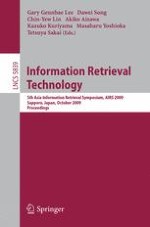2009 | Book
Information Retrieval Technology
5th Asia Information Retrieval Symposium, AIRS 2009, Sapporo, Japan, October 21-23, 2009. Proceedings
Editors: Gary Geunbae Lee, Dawei Song, Chin-Yew Lin, Akiko Aizawa, Kazuko Kuriyama, Masaharu Yoshioka, Tetsuya Sakai
Publisher: Springer Berlin Heidelberg
Book Series : Lecture Notes in Computer Science
